TOYOTA CELICA 1987 Service Repair Manual
Manufacturer: TOYOTA, Model Year: 1987, Model line: CELICA, Model: TOYOTA CELICA 1987Pages: 346, PDF Size: 35.13 MB
Page 331 of 346
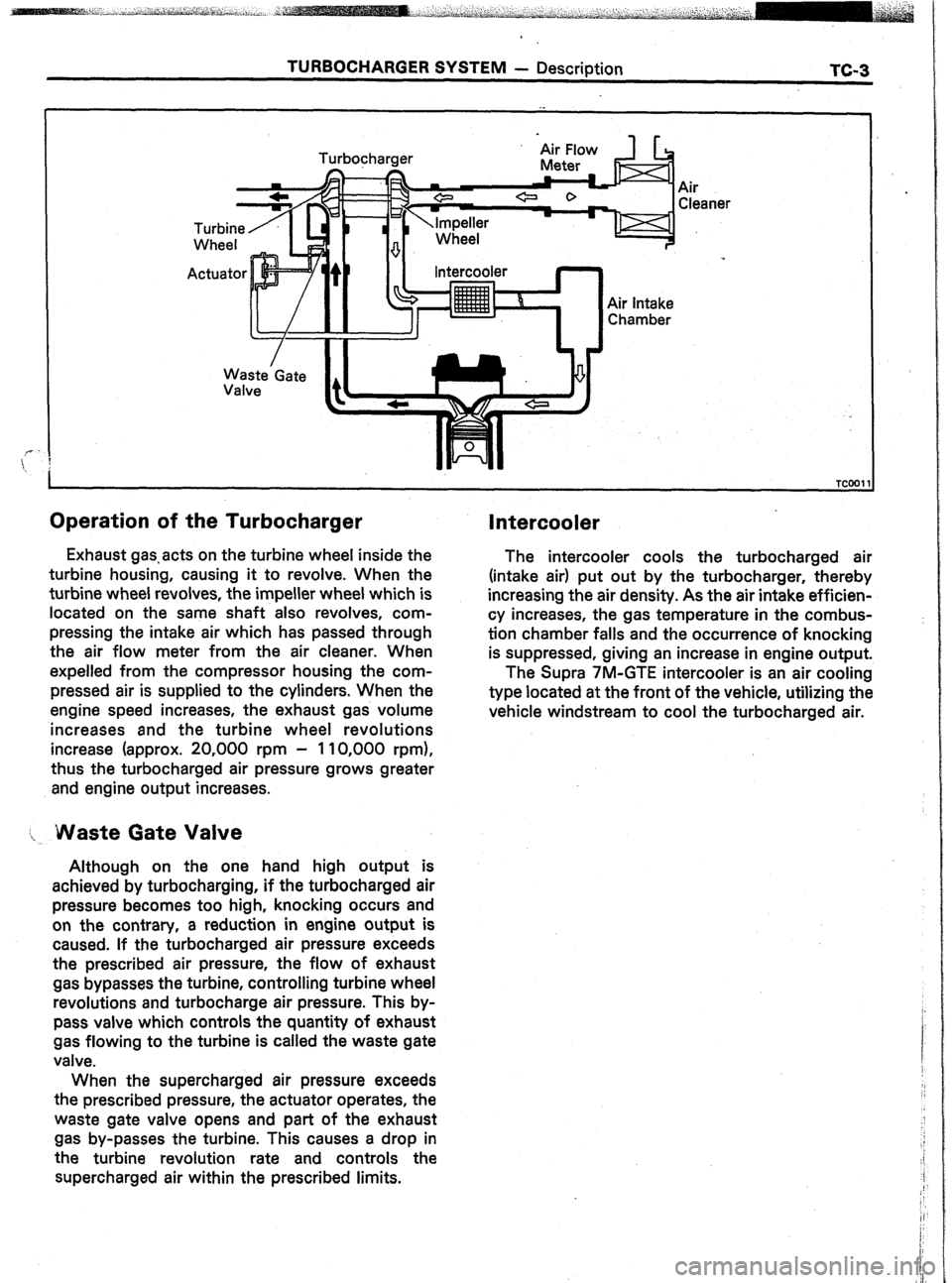
Air
Cleaner
i
Operation of the Turbocharger
Waste’Gate
Valve Intercooler
Air intake
Chamber
Exhaust gas.acts on the turbine wheel inside the
turbine housing, causing it to revolve. When the
turbine wheel revolves, the impeller wheel which is
located on the same shaft also revolves, com-
pressing the intake air which has passed through
the air flow meter from the air cleaner. When
expelled from the compressor housing the com-
pressed air is supplied to the cylinders. When the
engine speed increases, the exhaust gas volume
increases and the turbine wheel revolutions
increase (approx. 20,000 rpm - 110,000 rpm),
thus the turbocharged air pressure grows greater
and engine output increases.
I, Waste Gate Valve
Although on the one hand high output is
achieved by turbocharging, if the turbocharged air
pressure becomes too high, knocking occurs and
on the contrary, a reduction in engine output is
caused. If the turbocharged air pressure exceeds
the prescribed air pressure, the flow of exhaust
gas bypasses the turbine, controlling turbine wheel
revolutions and turbocharge air pressure. This by-
pass valve which controls the quantity of exhaust
gas flowing to the turbine is called the waste gate
valve.
When the supercharged air pressure exceeds
the prescribed pressure, the actuator operates, the
waste gate valve opens and part of the exhaust
gas by-passes the turbine. This causes a drop in
the turbine revolution rate and controls the
supercharged air within the prescribed limits.
Intercooler
The intercooler cools the turbocharged air
(intake air) put out by the turbocharger, thereby
increasing the air density. As the air intake efficien-
cy increases, the gas temperature in the combus-
tion chamber falls and the occurrence of knocking
is suppressed, giving an increase in engine output.
The Supra 7M-GTE intercooler is an air cooling
type located at the front of the vehicle, utilizing the
vehicle windstream to cool the turbocharged air.
Page 332 of 346
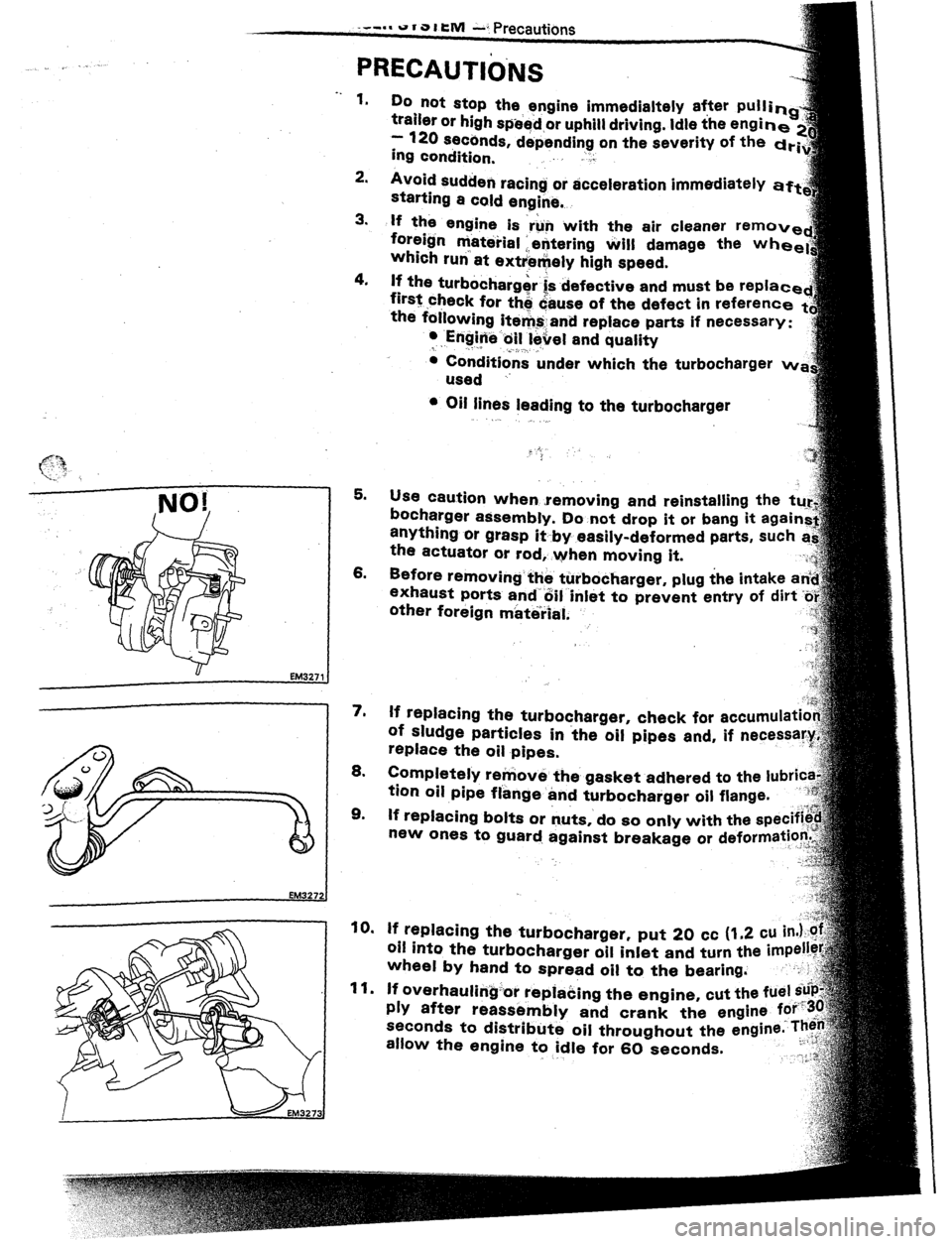
u EM3271
. .
1.
Do not stop the engine immedialtely after pullin
trailer or high speed or uphill driving. Idle the engin
- 126 seccnds, depending on the severity of the drf
ing condition, .,I
2.
Avoid sudden racing or acceleration immediately
starting a cold engine. aft
3.
If the engine is ‘run with the air cleaner remov
foreign material : entering Will damage the whe
which run’ at ext
lf the turbocharger i‘s .defective and must be replac
first check for thd &use of the defect in referent
the foilowing ite&and replace parts if necessary:
l .Engine:oil level and quality
c ,. ,_. .^
. I, .: .’
c Conditions under which the turbocharger MI
used ..
c Oil lines leading to the turbocharger
PRECAUTIO.NS
5.
use caution when .removing and reinstalling the
bocharger assembly. Do not drop it or bang it
anything or grasp it by easily-deformed parts,
the actuator or rod, .when moving it.
6.
other foreign material.
7.
lf replacing the turbocharger, check for accumulati
of sludge particles in the oil pipes and, if necessary
replace the oil pipes.
8.
EM327:
allow the engine
to idle for 60 seconds.
. ,-
Page 333 of 346
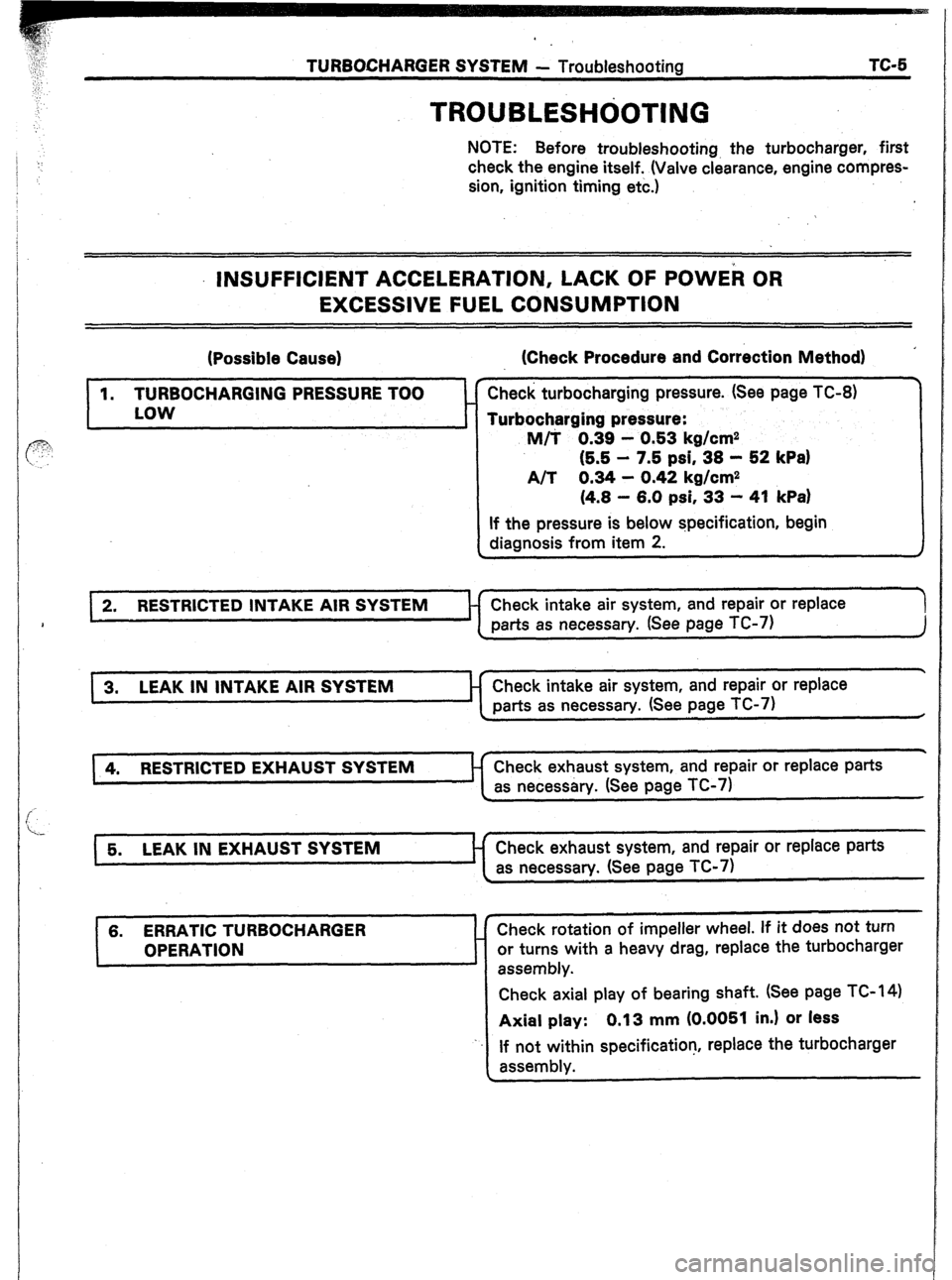
TURBOCHARGER SYSTEM - Troubleshooting TC-5
TROUBLESHdOTlNG
NOTE: Before troubleshooting the turbocharger, first
check the engine itself. (Valve clearance, engine compres-
sion, ignition timing etc.)
INSUFFICIENT ACCELERATION, LACK OF POWEk OR
EXCESSIVE FUEL CONSUMPTION
(Possible Cause)
I
1. TURBOCHARGING PRESSURE TOO
LOW
t
’ (Check Procedure and Correction Method)
Check turbocharging pressure. (See page TC-8)
Turbocharging pressure:
M/T 0.39 - 0.53 kg/cm2
(5.5 - 7.5 psi, 38 - S2 kPa)
A/T 0.34 - 0.42 kg/cm2
(4.8 - 6.0 psi, 33 - 41 kPa)
If the pressure is below specification, begin
diagnosis from item 2.
2. RESTRICTED INTAKE AIR SYSTEM Check intake air system, and repair or replace
‘1
parts as necessary. (See page TC-7)
J
.
3. LEAK IN INTAKE AIR Check intake air system, and repair or replace
parts as necessary. (See page TC-7)
.
4. RESTRICTED EXHAUST SYSTEM Check exhaust system, and repair or replace parts
as necessary. (See page TC-7)
Check exhaust system, and repair or replace parts
as necessary. (See page TC-7)
6. ERRATIC TURBOCHARGER
OPERATION Check rotation of impeller wheel. If it does not turn
or turns with a heavy drag, replace the turbocharger
assembly.
Check axial play of bearing shaft. (See page TC- 14)
Axial play: 0.13 mm (0.0051 in.) or less
If not within specification, replace the turbocharger
assembly.
Page 334 of 346
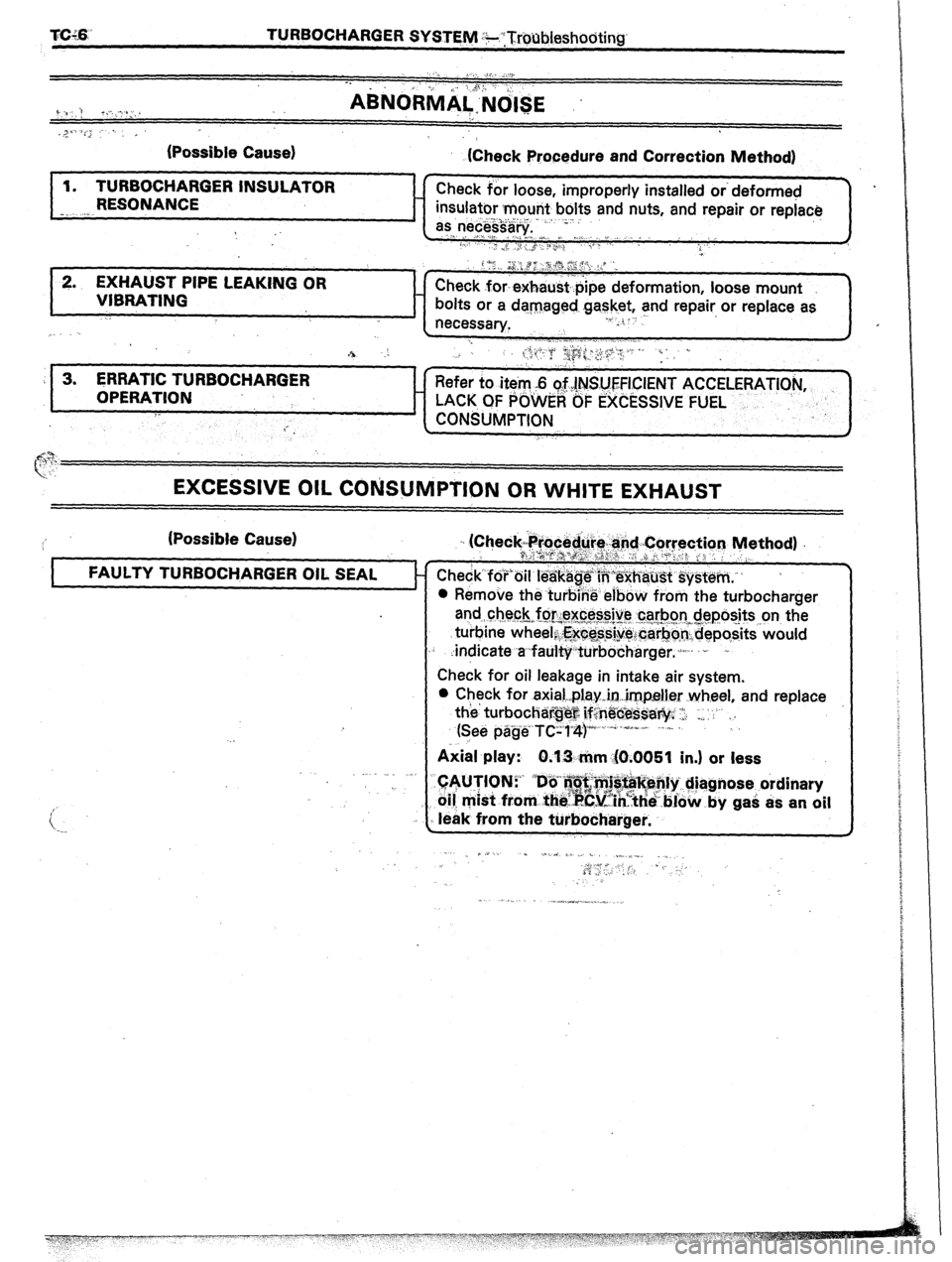
TCG6’ TURBOCHARGER SYSTEM +yTroubleshooting’
,.
a ,. .I<,) -;II
‘... ‘.
5 3 .;
*i‘ .:-i ‘> .,.
_. --ABN*AM~~~NO,SE
,3” ‘i> ‘. ,
‘,
(Possible Cause)
.(Check Procedure and Correction Method)
1. TURBOCHARGERINSULATOR
’ Check for loose, improperly installed or deformed 7 .
RESONANCE
_. .._.
L insulator mount bolts and nuts, and repair or replace
as necggga’q*‘ :: ;”
% . . .** ,.s, ~ . . .x ,, ,;jl i, ,
.;.
:’ J ;( ,F :t :‘^” -a I
-,
i A,* “‘2 ,I IIS i .;. ,,+ r-i id
.:, .a$,,* !! < , ,c.‘u.i,!.,: i’ ,.,* ‘.
3. EXHAUST PIPE LEAKING OR I ._ /
Check -for-etibaustpipe deformation, loose mount
VIBRATING
--/ bolts or a damaged .gasket, and repair or replace as
necessary, ,.. .* / ,, .: ‘.
I
-.
,” ,I ,,_, __ ,. ..^1.. /
.% .I .i .‘ !, ,, ,~ <> .‘p “,. ,A;. $ 1( ,. .( 1 -.. .- .
2 -$$q+,, ,:: F ‘j. Ij
,j ‘. ,
3. ERRATIC TURBOCHARGER c
3
OPERATION Refer to ite’m :6 of.@SUFFICIENT ACCELERATION,
LACK, QF POW&R OF El’kCiSSIVE FUEL :
>
> CONSUMPTION
x .
., J
(fy
EXCESSIVE OIL COhlSUMPTION OR WHITE EXHAUST i
(Possible Cause)
L FAULTY TURBOCHARGER OIL SEAL
I- Chedk fd’~o’il le;~~~~~ ‘~~‘“ir~~a~~t ~~sti?iri,.
l Remove the turbine el’bow from the turbocharger
and., check for .excessive carbon depdsjts .on the
.,..we - -..... _, .,., ll.~ I~ . . . . . _.~__” ..- ).,/.. ,,a,.*“, ,‘*<*\. ,..
turbine wheel~~~~~~~~.sl~~~~ar,~o,~;:.depqsits would
.indicate ,a--faultyturbocharger.-‘~, .’
Check for oil leakage in intake air system.
l Check for axial...play,.io.imp.eller.wheel, and replace
thb’ turboch@$~$ iflng&$ja#y +: ___ :’
ISee pagk.‘TC”.T$j+=“*~ . . *. .._- _. __
Axial play: 0.13 mm 40.0051 in.) or less
C&JTIONf~ ~~~~.~~~,“~~~~~~~;hl~.diagirose ordinary
._ . 3 .*a p9 i e&f & ? c ” .
oil, mist from. tha.)?C~Y~.ln~.tti~~,~~ow by gaS as an oil
leak from the turbocharger.
Page 335 of 346
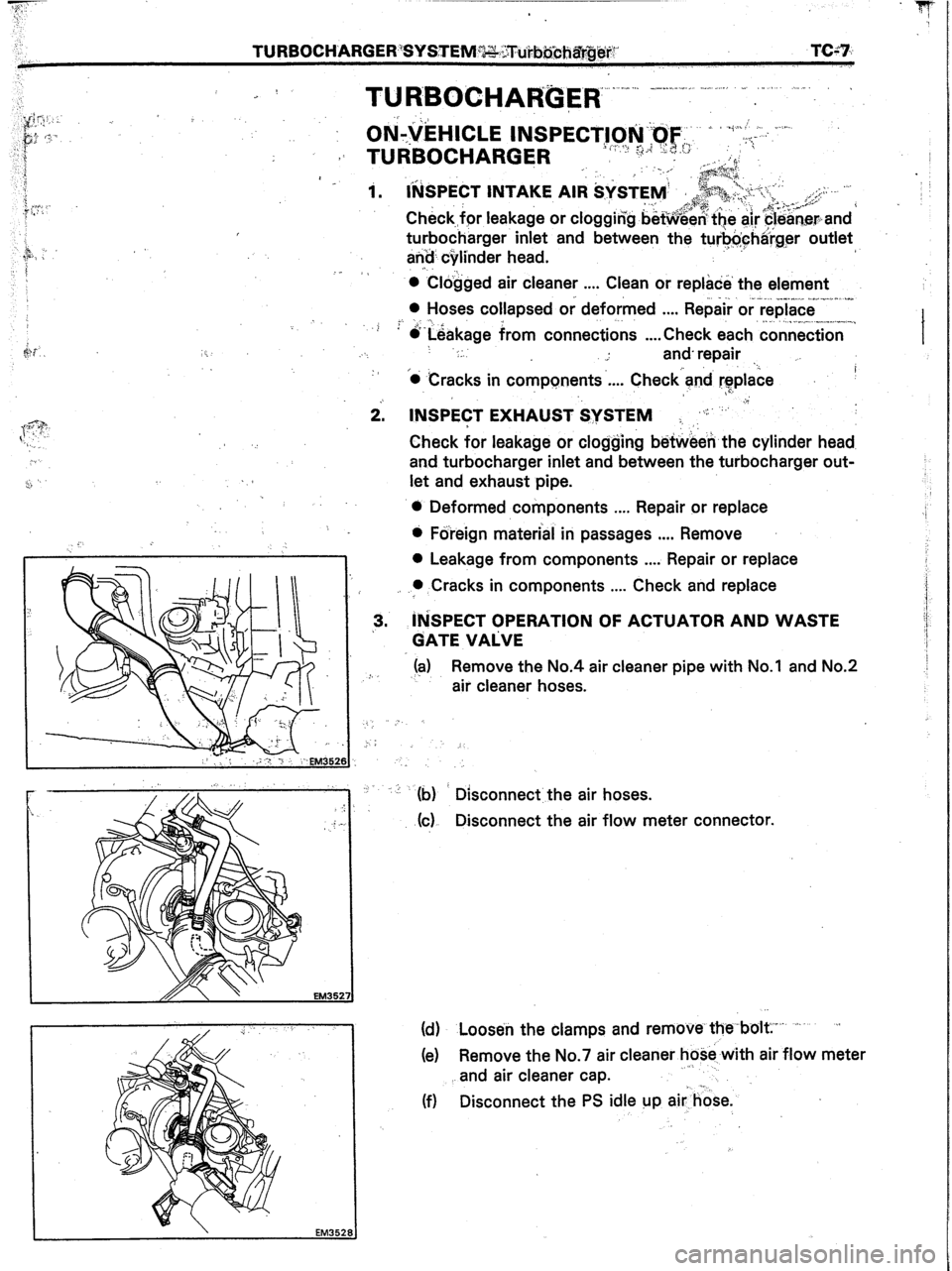
$v 0 Clogged air cleaner . . . .
Clean or replace the element
.
“_“.^^. ...” _..,. .., ._
0 Hoses collapsed or deformed . . . . Repair or replace
. .
” &-Leakage from connections ...” .._._^ _ _..- -_.
)
. . . . Check each connection
.:.. .
,: and. repair
. .
. . . ‘:.
:
0 Cracks in components..... Check and replace ,
$C,
2.
INSPECT EXtlAUST~kYsTEM ,. .:I’ “’ ‘-
’
Check for leakage or clogging between the cylinder head
and turbocharger inlet and between the turbocharger out-
let and exhaust pipe.
0 Deformed components . . . . Repair or replace
6 Foreign material in passages . . . . Remove
j : ‘-EM3521
l Leakage from components . . . . Repair or replace
.( 0 Cracks in components . . . . Check and replace
3. ~WPECT OPERATION OF ACTUATOR AND WASTE
GATE
VAiVE
(a) Remove the No.4 air cleaner pipe with No.1 and No.2
air cleaner hoses.
” (b) ’ Disconnect the air hoses.
(cl Disconnect the air flow meter connector.
(. :
// ’
1 (d) Loosen the clamps and remove. the-bolt:. ~’
(e) Remove the No.7 air cleaner hose with air flow meter
and air cleaner cap.
.,
(f) Disconnect the PS idle up air hose.
Page 336 of 346
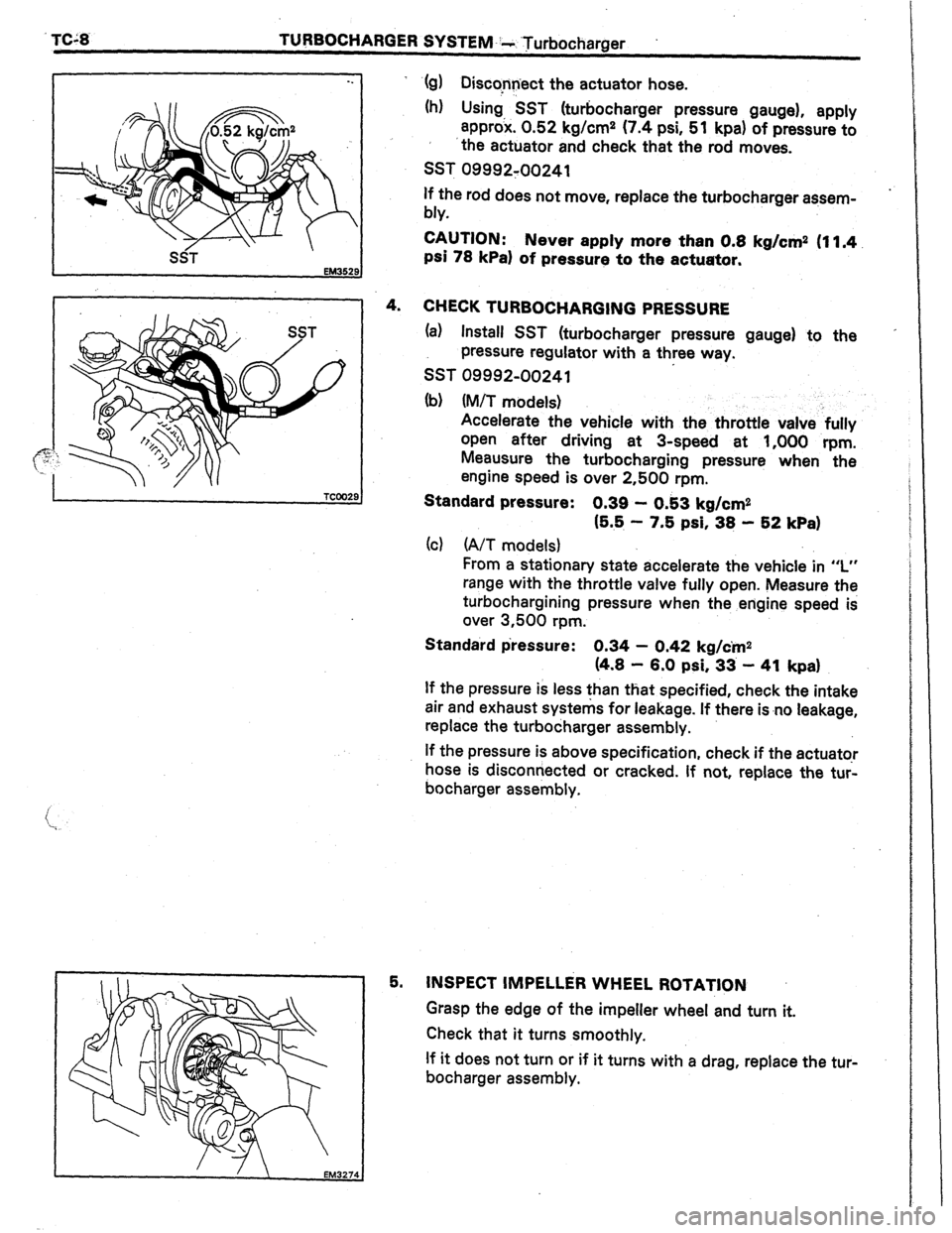
TC;8 TUWOCHARGER SYSTEM--- Turbocharger
-. ‘(g) Disccnnect the actuator hose.
(h) Using, SST (turbocharger pressure gauge), apply
approx. 0.52 kg/cm2 (7.4 psi, 51 kpa) of pressure to
‘the actuator and check that the rod moves.
SST 09992:00241
SST
EM352!
If the rod does not move, replace the turbocharger aasem-
bly.
CAUTION: Never apply more than 0.8 kg/cm2 (11.4.
psi 78 kPa1 of pressure to the actuator.
4.
CHECK TURBOCHARGING PRESSURE
(a) Install SST (turbocharger pressure gauge) to the
pressure regulator with a three way.
SST 09992-00241
(b) (M/T models)
Accelerate the vehicle with the throttle valve fully
open after driving at 3-speed at 1,000 rpm.
Meausure the turbocharging pressure when the
engine speed is over 2,500 rpm.
Standard pressure:
0.39 - 0.53 kg/cm2
(6.8 - 7.8 psi, 38 - 82 kPa)
(c) (A/T models)
From a stationary state accelerate the vehicle in I”
range with the throttle valve fully open. Measure the
turbochargining pressure when the engine speed is
over 3,500 rpm.
Standard p‘ressure: 0.34 - 0.42 kg/em2
(4.8 - 8.0 psi, 33 - 41 kpa)
If the pressure is less than that specified, check the intake
air and exhaust systems for leakage. If there isno leakage,
replace the turbocharger assembly.
If the pressure is above specification, check if the actuator
hose is disconnected or cracked. If not, replace the turl
bocharger assembly.
I l,Il - 1 5, INSPECT IMPELLiR WHEEL ROTATION
/-L
EM32
Grasp the edge of the impeller wheel and turn it.
Check that it turns smoothly.
If it does not turn or if it turns with a drag, replace the tur
bocharger assembly.
1 :74
Page 337 of 346
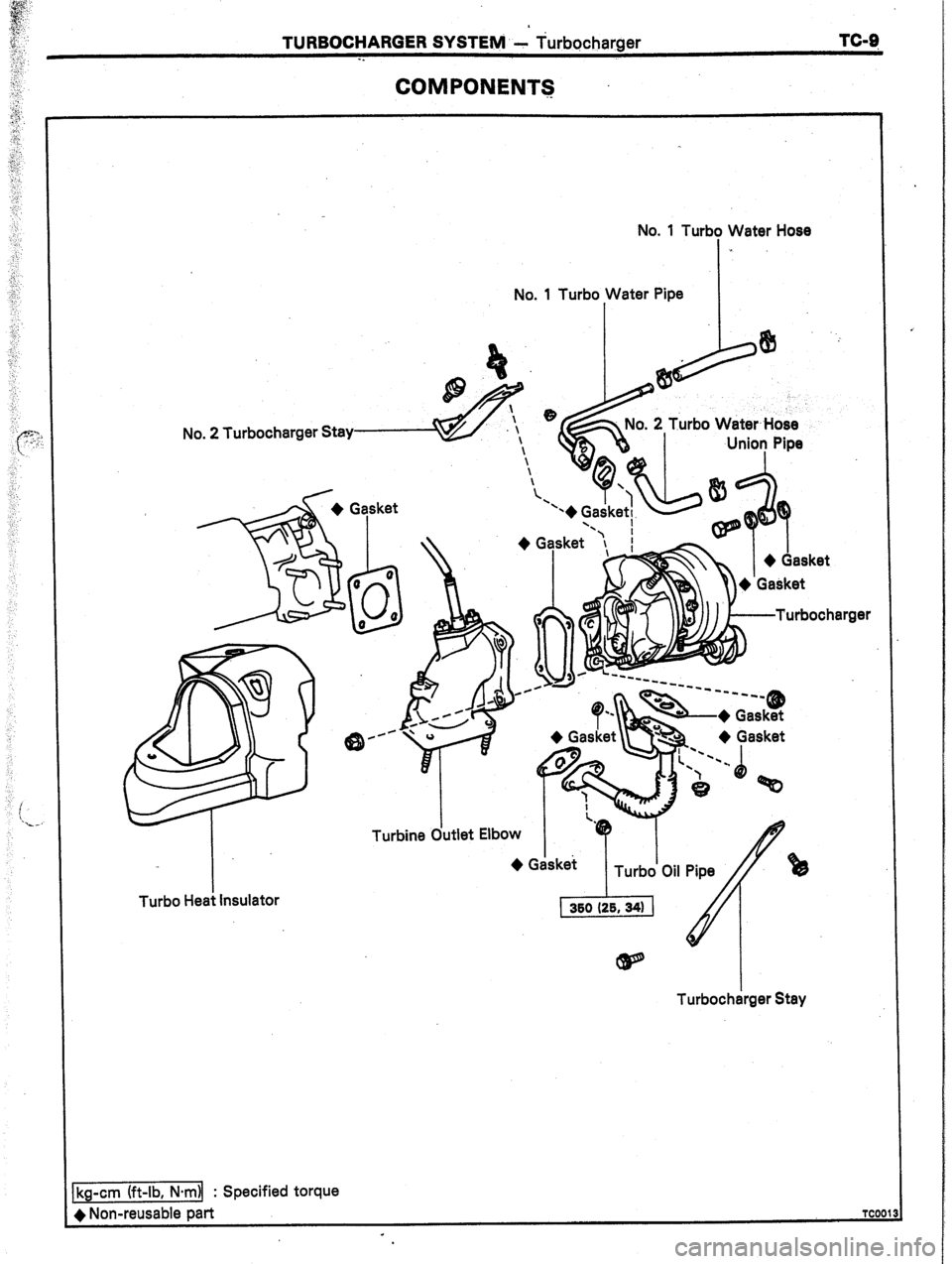
TURBOCHARGER SYSTEM -’ iurbqcharger
-. TC-8
COMPONENTS
No. 1 Turbo Water Hose
I,
No. 1 Turbo Water Pipe
I
No. 2 Turbocharger Stay -s&z .‘I,,
”
Turbo Heat insulator Turbine dutlet Elba
Turbocharger Stay
]kg-cm (ft-lb, N.rn)l : Specified torque
+ Non-reusable part
Page 338 of 346
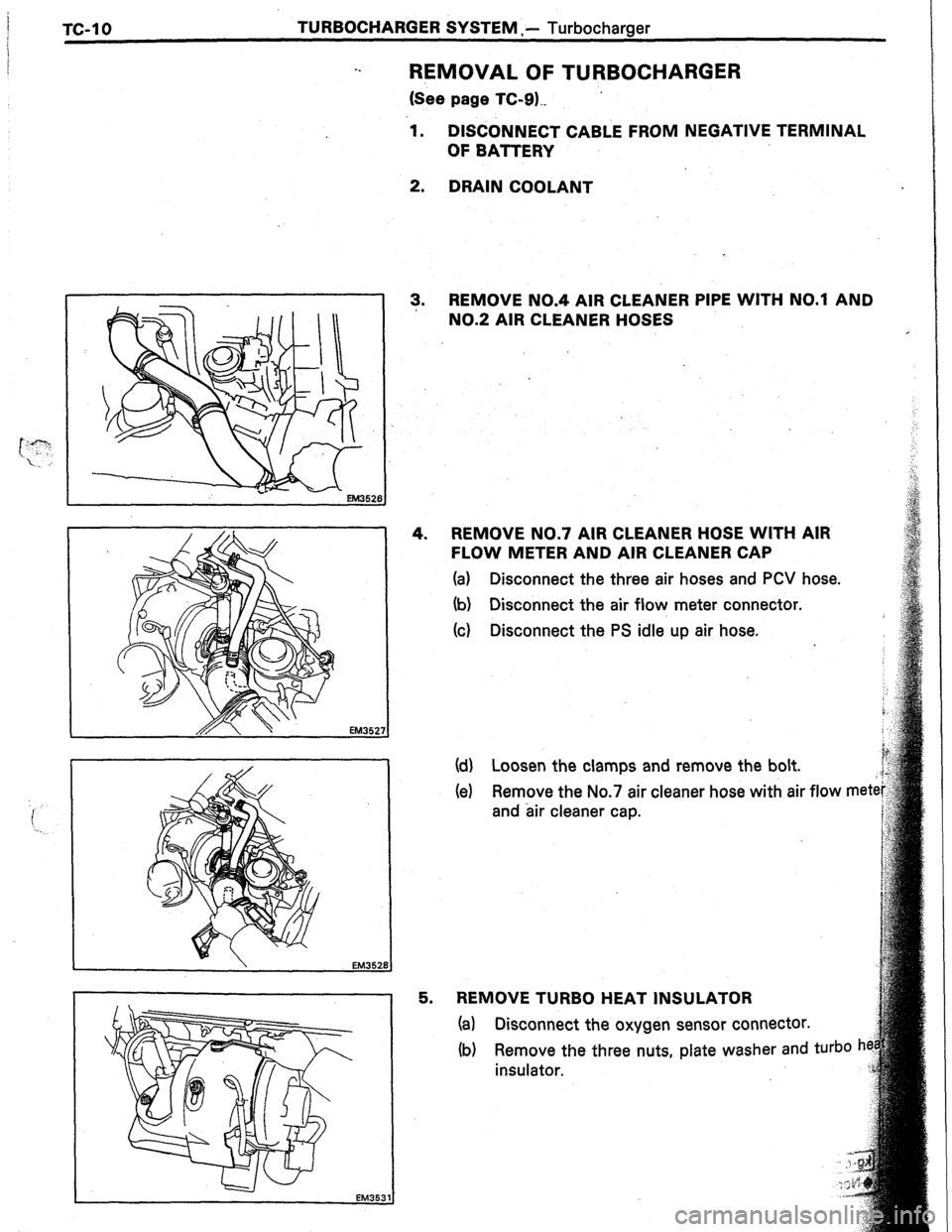
m-1 0 TURBOCHARGER SYSTEM .- Turbocharaer
. .
REMOVAL OF TURBOCHARGER
(See page TC-91..
1.
DISCONNECT CABLE FROM NEGATIVE TERMINAL
OF BATTERY
2. DRAIN COOLANT
1 3.
REMOVE NO.4 AIR CLEANER PIPE WITH NO.1 AND
NO.2 AIR CLEANER HOSES
4. REMOVE NO.7 AIR CLEANER HOSE WITH AIR
FLOW METER AND AIR CLEANER CAP
(a) Disconnect the three air hoses and PCV hose.
(b) Disconnect the air flow meter connector.
(cl Disconnect the PS idle up air hose.
I (d) Loosen the clamps and remove the bolt.
1 EM3528
5. (e) Remove the No.7 air cleaner hose with air flow mete#
and air cleaner cap. i.,%$
: ,::j
REMOVE TURBO HEAT INSULATOR
(a) Disconnect the oxygen sensor connector.
(b) Remove the three nuts, plate washer and turbo h’
insulator.
Page 339 of 346
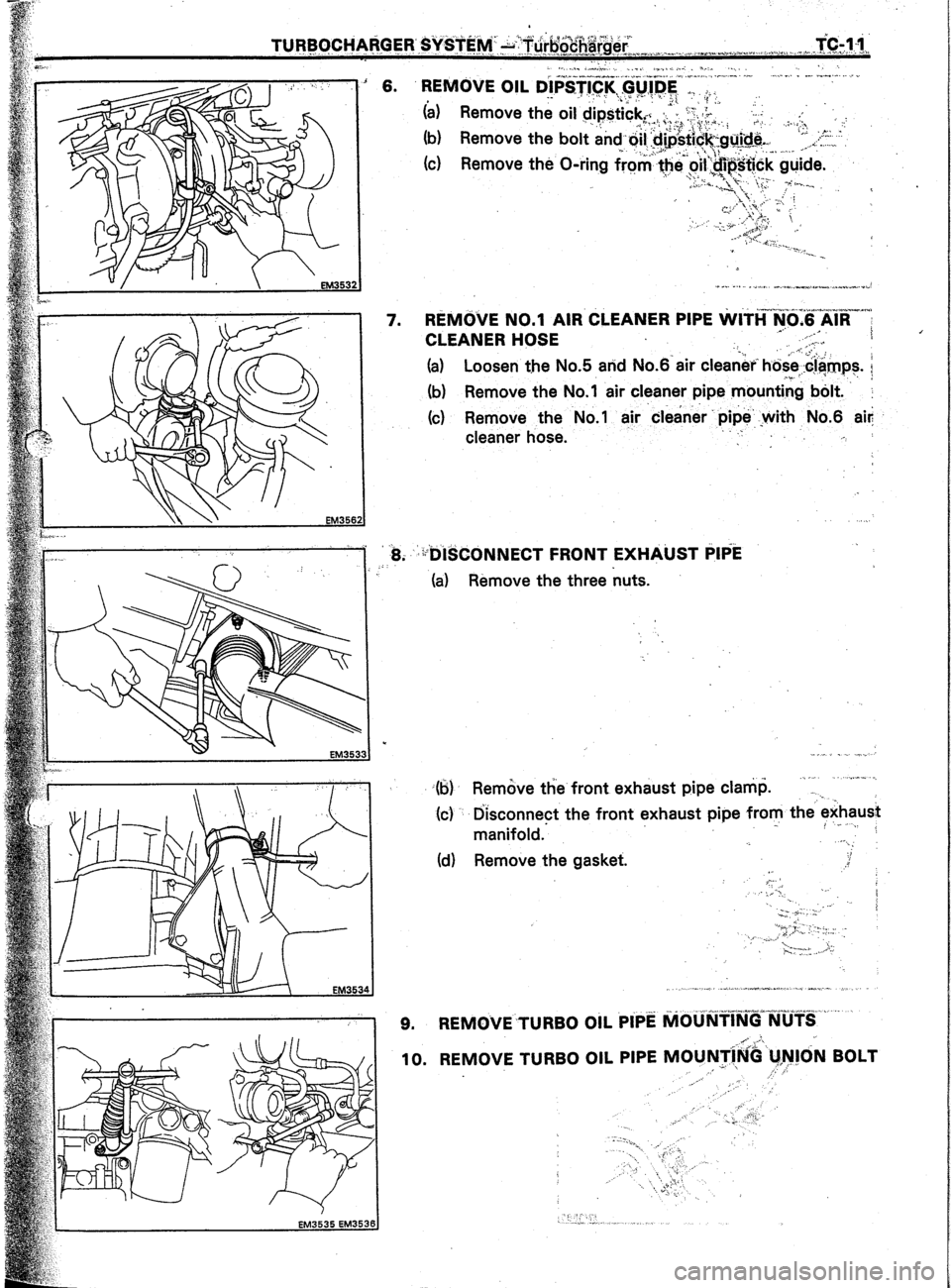
A 6.
7.
.._.. .-.. . .^.. ^. ~/.l..*l.- .,.I. >““..“I
REM6vE N0*1 A,R CLEANER P,PE Wi-~N”“:Vld;l^d-.~‘i
_.’
CLEANER HOSE ,.... ’
i . ‘.., -’ e
(a) Loosen the No.5 and No.6 air cleaner’hdse~,&$nps. i
(b) Remove the No.1 air cleaner pipe mounting bolt. :
(c) Remove the No.1 air cleaner. pipe’. with No.6 air
cleaner hose. :
. . ,_ :
. .
“;DiSCONNECT FRONT EXHAUST PIP’k
(a) Remove the three nuts.
..i, . -,,
:(b) Remove the front exhaust pipe clamp. _ “‘-- G
(c) disconnect the front exhaust pipe from the ex-haush
manifold.. -.
” !
I-‘~
(d) Remove the gasket. :,
,.I
.-
,..‘..
,..
I
. 9. REMO’VE‘TURBO OIL PIPE MOUNTING NUTS
.-. <;,:p
10. REMOVE TURBO OIL PIPE MOlJNJ..NG y,N!ON BOLT
?
EM3535 EM35361 . : ;.‘I... _., ._
Page 340 of 346
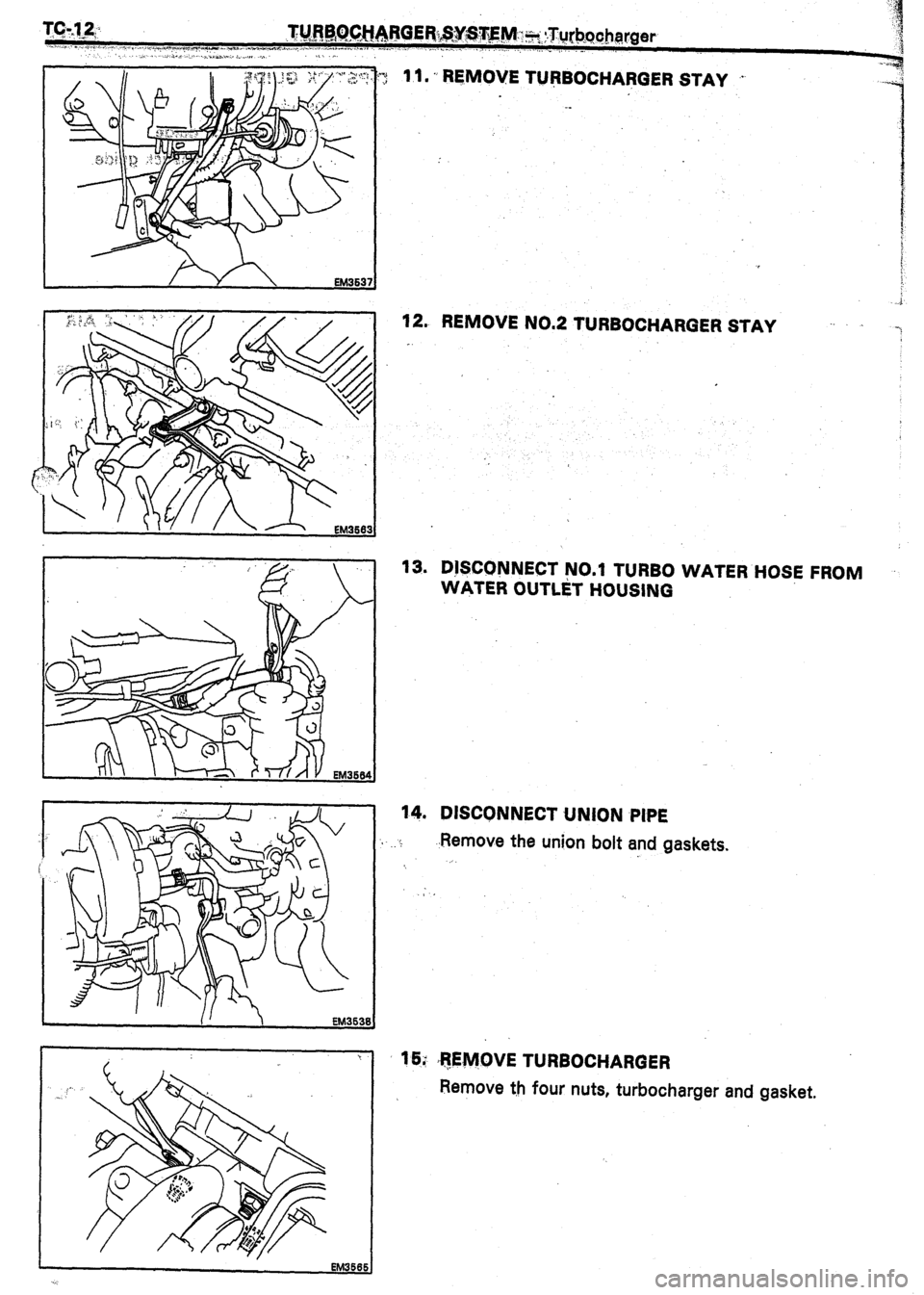
I EM363
t 11 l REMOVE TURBOCHAFjGER STAY .
-6
12. REMOVE NO.2 TURBOCHARGER STAY
.-
13. DjSCONNECT NO.1 TURBO WATER HOSE FROM
WATER OUTliT HOUSING
14. DISCONNECT UNION PIPE
1
.Remove the union bolt and gaskets.
i
15; @EMOVE TURBOCHARGER
Remove t,h four nuts, turbocharger and gasket.
EM3665,
“.